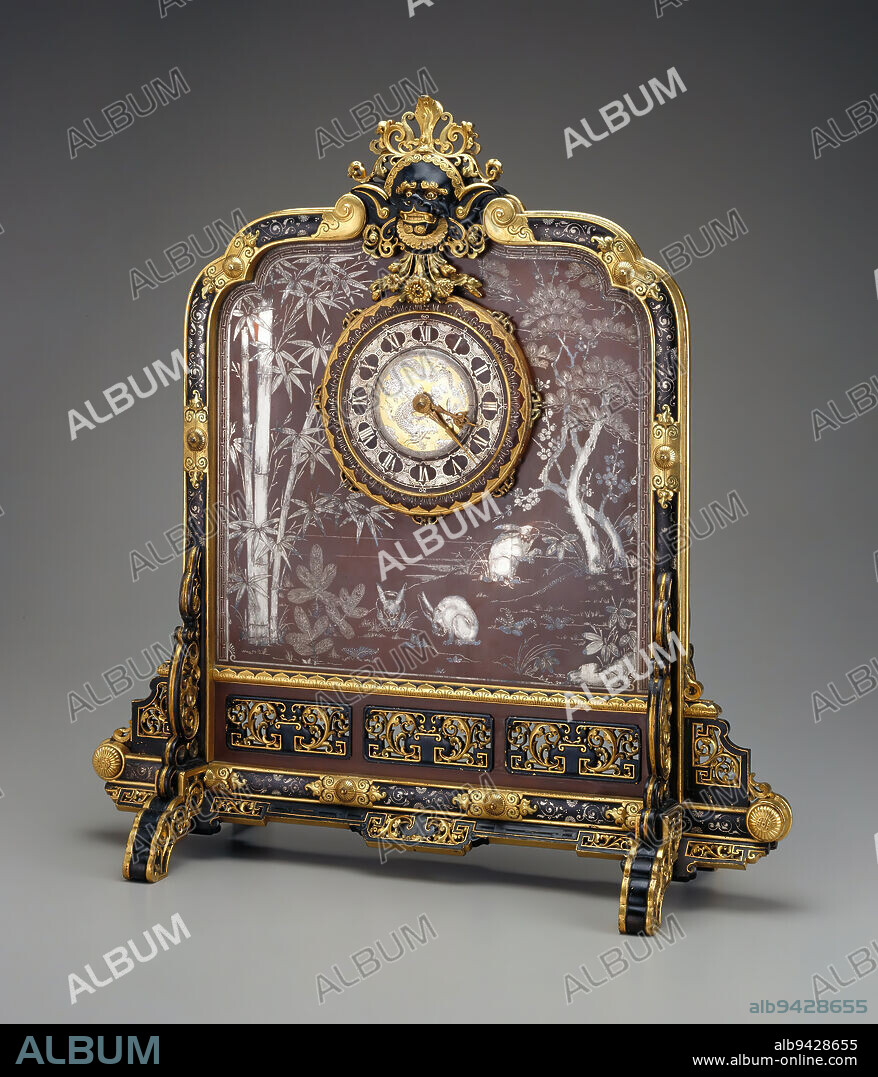alb9428655
Clock, c. 1869, Emile-Auguste Reiber; Maker: Christofle, French, 1826-1893, 20 1/2 x 19 1/2 x 7 3/4 in. (52.07 x 49.53 x 19.69 cm)6 1/2 x 2 3/8 x 7/8 in. (16.51 x 6.03 x 2.22 cm) (pendulum), Silver, bronze, copper, gilt, pigment, France, 19th century, This magnificent clock illustrates some of the earliest Japanese influences on European decorative arts following the reopening of Japan to the Western world in 1854. The clock combines European and Asian iinfluences. Its overall form is derived from an 18th-century Chinese table screen; the face and whimsical beast above it is inspired by Tibetan mandalas; and the silver inlay depicts scenes taken from Japanese paintings, lacquerware, and ceramics.

|
Add to another lightbox |
|
Add to another lightbox |



Buy this image.
Select the use:

Caption:
Clock, c. 1869, Emile-Auguste Reiber; Maker: Christofle, French, 1826-1893, 20 1/2 x 19 1/2 x 7 3/4 in. (52.07 x 49.53 x 19.69 cm)6 1/2 x 2 3/8 x 7/8 in. (16.51 x 6.03 x 2.22 cm) (pendulum), Silver, bronze, copper, gilt, pigment, France, 19th century, This magnificent clock illustrates some of the earliest Japanese influences on European decorative arts following the reopening of Japan to the Western world in 1854. The clock combines European and Asian iinfluences. Its overall form is derived from an 18th-century Chinese table screen; the face and whimsical beast above it is inspired by Tibetan mandalas; and the silver inlay depicts scenes taken from Japanese paintings, lacquerware, and ceramics.
Credit:
Album / quintlox
Releases:
Model: No - Property: No
Rights questions?
Rights questions?
Image size:
2693 x 3141 px | 24.2 MB
Print size:
22.8 x 26.6 cm | 9.0 x 10.5 in (300 dpi)
Keywords:
16.51 X 6.03 X 2.22 CM • 1826-1893 • 1854 • 1869 • 18TH-CENTURY CHINESE TABLE SCREEN • 19 CENTURY • 19TH CENTURY • 19TH • 19TH-CENTURY • ARTFORM: BRONZEWORK • ASIAN IINFLUENCES • BRONCE • BRONZE BRASS • BRONZE • BRONZES • CERAMICS • CHRISTOFLE • CLOCK COMBINES EUROPEAN • CLOCK • COPPER • COPPERWORK • DERIVED • EARLIEST JAPANESE INFLUENCES • EMILE-AUGUSTE REIBER • EUROPEAN DECORATIVE ARTS FOLLOWING • FACE • FRANCE • FRENCH • GILT • INSPIRED • JAPAN • JAPANESE PAINTINGS • JAPANESE • LA FRANCE • LACQUERWARE • MAGNIFICENT CLOCK ILLUSTRATES • MAKER • NINETEENTH CENTURY • OVERALL FORM • PENDULUM • PIGMENT • REOPENING • SILVER INLAY DEPICTS SCENES • SILVER • TIBETAN MANDALAS • VISAGE • WESTERN WORLD • WHIMSICAL BEAST • XIX CENTURY
 Pinterest
Pinterest Twitter
Twitter Facebook
Facebook Copy link
Copy link Email
Email
